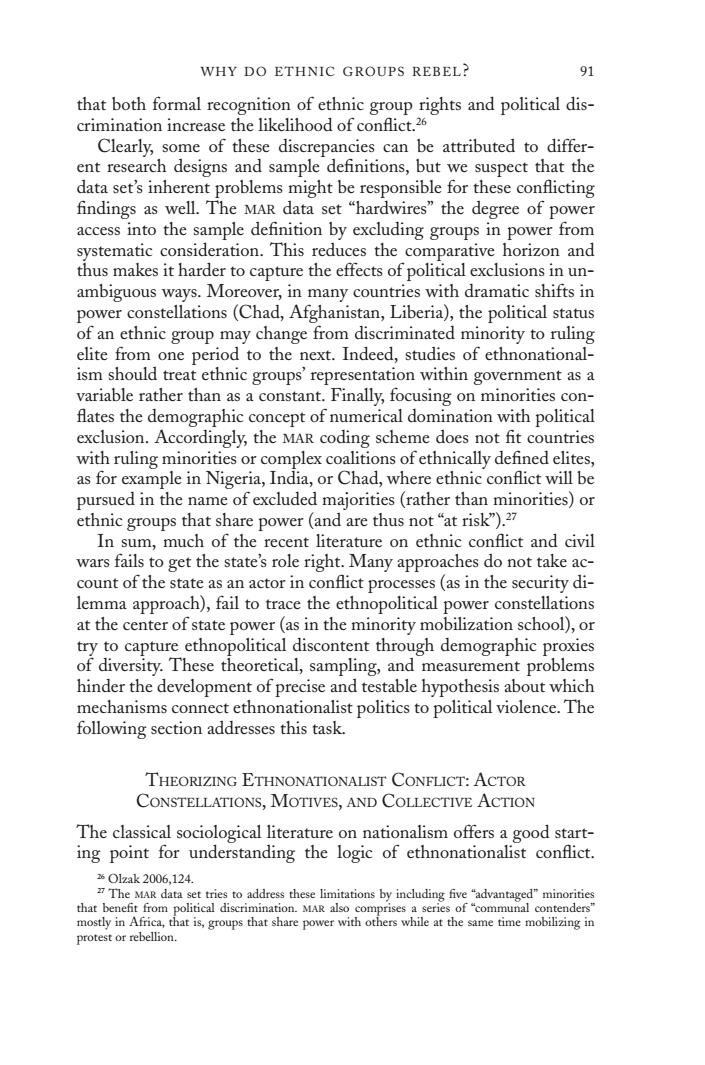正在加载图片...

WHY DO ETHNIC GROUPS REBEL? 91 that both formal recognition of ethnic group rights and political dis- crimination increase the likelihood of conflict.26 Clearly,some of these discrepancies can be attributed to differ- ent research designs and sample definitions,but we suspect that the data set's inherent problems might be responsible for these conflicting findings as well.The MAR data set "hardwires"the degree of power access into the sample definition by excluding groups in power from systematic consideration.This reduces the comparative horizon and thus makes it harder to capture the effects of political exclusions in un- ambiguous ways.Moreover,in many countries with dramatic shifts in power constellations(Chad,Afghanistan,Liberia),the political status of an ethnic group may change from discriminated minority to ruling elite from one period to the next.Indeed,studies of ethnonational- ism should treat ethnic groups'representation within government as a variable rather than as a constant.Finally,focusing on minorities con- flates the demographic concept of numerical domination with political exclusion.Accordingly,the MAR coding scheme does not fit countries with ruling minorities or complex coalitions of ethnically defined elites, as for example in Nigeria,India,or Chad,where ethnic conflict will be pursued in the name of excluded majorities(rather than minorities)or ethnic groups that share power(and are thus not"at risk").27 In sum,much of the recent literature on ethnic confict and civil wars fails to get the state's role right.Many approaches do not take ac- count of the state as an actor in conflict processes(as in the security di- lemma approach),fail to trace the ethnopolitical power constellations at the center of state power (as in the minority mobilization school),or try to capture ethnopolitical discontent through demographic proxies of diversity.These theoretical,sampling,and measurement problems hinder the development of precise and testable hypothesis about which mechanisms connect ethnonationalist politics to political violence.The following section addresses this task. THEORIZING ETHNONATIONALIST CONFLICT:ACTOR CONSTELLATIONS,MOTIVES,AND COLLECTIVE ACTION The classical sociological literature on nationalism offers a good start- ing point for understanding the logic of ethnonationalist conflict. 2 Olzak2006,124. The MAR data set tries to address these limitations by including five"advantaged"minorities that benefit from political discrimination.MAR also comprises a series of"communal contenders" mostly in Africa,that is,groups that share power with others while at the same time mobilizing in protest or rebellion.why do ethnic groups rebel? 91 that both formal recognition of ethnic group rights and political discrimination increase the likelihood of conflict.26 Clearly, some of these discrepancies can be attributed to different research designs and sample definitions, but we suspect that the data set’s inherent problems might be responsible for these conflicting findings as well. The mar data set “hardwires” the degree of power access into the sample definition by excluding groups in power from systematic consideration. This reduces the comparative horizon and thus makes it harder to capture the effects of political exclusions in unambiguous ways. Moreover, in many countries with dramatic shifts in power constellations (Chad, Afghanistan, Liberia), the political status of an ethnic group may change from discriminated minority to ruling elite from one period to the next. Indeed, studies of ethnonationalism should treat ethnic groups’ representation within government as a variable rather than as a constant. Finally, focusing on minorities conflates the demographic concept of numerical domination with political exclusion. Accordingly, the mar coding scheme does not fit countries with ruling minorities or complex coalitions of ethnically defined elites, as for example in Nigeria, India, or Chad, where ethnic conflict will be pursued in the name of excluded majorities (rather than minorities) or ethnic groups that share power (and are thus not “at risk”).27 In sum, much of the recent literature on ethnic conflict and civil wars fails to get the state’s role right. Many approaches do not take account of the state as an actor in conflict processes (as in the security dilemma approach), fail to trace the ethnopolitical power constellations at the center of state power (as in the minority mobilization school), or try to capture ethnopolitical discontent through demographic proxies of diversity. These theoretical, sampling, and measurement problems hinder the development of precise and testable hypothesis about which mechanisms connect ethnonationalist politics to political violence. The following section addresses this task. Theorizing Ethnonationalist Conflict: Actor Constellations, Motives, and Collective Action The classical sociological literature on nationalism offers a good starting point for understanding the logic of ethnonationalist conflict. 26 Olzak 2006,124. 27 The mar data set tries to address these limitations by including five “advantaged” minorities that benefit from political discrimination. mar also comprises a series of “communal contenders” mostly in Africa, that is, groups that share power with others while at the same time mobilizing in protest or rebellion